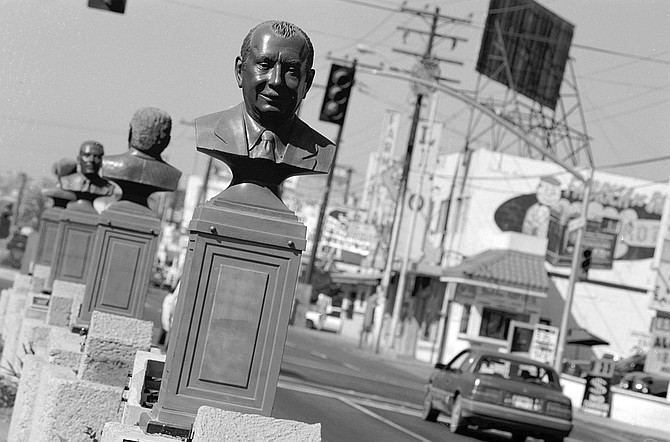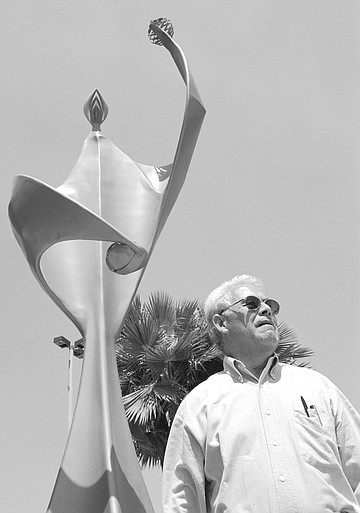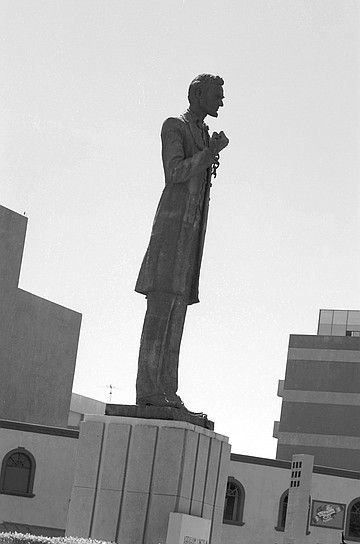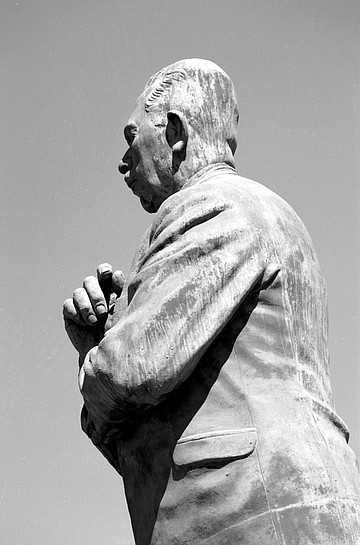 Facebook
Facebook
 X
X
 Instagram
Instagram
 TikTok
TikTok
 Youtube
Youtube

"Just like Florence, just like Rome, Tijuana, too, has its monuments."
Professor Julio Rodríguez steers his blue Ford through Zona Rio, gesturing at one statue after another.
"And what are monuments? What do they represent? They represent the dreams, the history, the values of a people, of a culture."

Professor Rodríguez twice circles a roundabout dominated by a statue of Cuauhtémoc, the last Aztec emperor.
"The Spaniards shoved Cuauhtémoc's feet into fire to make him say where the Aztecs hid their gold. Of course, he didn't tell them anything.
"The Mexican government donated an exact copy of this statue to the French government. This Cuauhtémoc stands in Tijuana and Paris."
In late summer, the Tijuana daily El Mexicano noted that one of the city's civic organizations presented Professor Rodríguez with an award for promoting "public awareness of Tijuana's historic monuments."

In 1998, Professor Rodríguez published the first edition of La Ruta de los Monumentos Historicos de Tijuana, a complete guide to the monuments. He's now correcting the galleys for the book's fifth edition.

"There are more than 60 historic monuments in Tijuana. No one knew there were so many. Even Tijuanenses, Tijuana natives, didn't know. So my book was quite a surprise."
Professor Rodríguez, accompanied by Asunción, his wife, was eager to take me to several of his favorites, but he first wanted to show me something else close his heart, "a true gem, a marvelous gift to Tijuana." East of downtown in Colonia Corona del Rosal, we turn down Ermita Norte Street and come to a large, new two-story building: the Tijuana Historical Society.

"The story behind this building is actually kind of romantic," Professor Rodríguez says as he ushers me and Asunción inside. He points to a plaque above the auditorium's entrance, "You see that the auditorium is dedicated to Professor Arturo Pompa. Well, Professor Pompa was the elementary school teacher of Ernesto Jimenez, the very successful founder of Jersey Dairies here in Tijuana. Professor Pompa was a member of the Tijuana historical society, and in the late 1980s he invited Jimenez to come to one of the society's monthly meetings and give a presentation on the history of Tijuana's dairy industry.
The presentation was well received, and afterward, while talking about the historical society, Professor Pompa explained to Jimenez that since the society was founded in 1976, its 80 members had met in cafés and in members' homes but had no permanent place to hold meetings or for its books and papers. Professor Pompa was Jimenez's favorite teacher, and Jimenez had always remembered him fondly. Jimenez said to the professor, 'Tell the society to find a piece of land, and I will build you a center for the historical society.'
"This was something very remarkable, because we don't yet really have that tradition in Mexico, the tradition of private individuals sponsoring cultural institutions. So, the society looked and looked for a piece of land. Jimenez created a foundation for the society and the building. In 1997 the State of Baja California donated this land to us, and in 1998 the building was completed. I've heard that it cost half a million dollars. It's a marvel. In it's way, it's also a monument. The only other Mexican city that has a building for its historical society is Veracruz."
Ermita Norte Street is hot and dusty, but the society's rooms are high ceilinged and air conditioned. The floors are of pale marble, and to the right of the receptionist a gallery exhibits a permanent collection of photographs from Tijuana's past. School children in blue and white uniforms race through the building's front door. Waving at them, Professor Rodríguez says, "These are Tijuana children, coming to learn about their city's and state's history. Have you ever seen anything more beautiful? Every month nearly 900 students visit the society to hear lectures or work on school projects."
For many years Professor Rodríguez taught Spanish at Lázaro Cárdenas, one of Tijuana's best public secondary schools, where Asunción taught dance. She is a petite, finely boned woman who unobtrusively smooths her husband's collar and who sotto voce reminds him of details he can't recall. She whispers that we should go.
We proceed down Boulevard Agua Caliente, whose median serves as a sculpture garden. Sixteen bronze busts of "Tijuana's founders" — businessmen, lawyers, politicians — stare westward down the boulevard.
"There's room," Professor Rodríguez says, "for at least four more busts. But not all our monuments are of Mexicans. At the intersection of Paseo de los Héroes and Avenida Diego Rivera we have a statue of Abraham Lincoln. In his hands he holds a broken chain, symbolizing the liberation of American slaves. Why does Tijuana have a statue of Lincoln? Because we consider him the greatest American of the 19th Century. Mexicans also remember him because he was the only American senator who opposed President Polk's intervention in Mexico. He said the war with Mexico was unnecessary and unconstitutional."
Professor Rodríguez's 150-page book not only describes Tijuana's major monuments, it also visits those that tourists won't likely see. Way out in the Lomas Taurinas district stands a large bust of Luis Donaldo Colosio near the spot where the presidential candidate was assassinated on March 23, 1994. Near downtown, on Second Street, between Streets H and I, stands a bust of Héctor Félix Miranda, the Tijuana journalist who was assassinated on April 20, 1988.
One of Professor Rodríguez's favorite monuments, however, is one that many Americans on their way home from the racetrack have probably seen but not understood. Where Boulevards Salinas and Agua Caliente converge, seven concrete children scramble up the cover of an enormous concrete book. Pulling his car up beside the structure, Professor Rodríguez explains, "This is the monument to the 'free textbook.'
"One of what you might call the 'cultural fruits' of the Mexican Revolution was that the government decided to print all textbooks and offer them for free to primary and secondary students. Education was no longer for the rich. In 1965, the mayor of Tijuana, Idelfonso Velázquez, had this monument built. He was driven by two noble sentiments. One was his patriotism. The other was his gratitude and affection for his friend, President Adolfo López Mateos, who had instituted the free textbook."
Professor Rodríguez wants me to see Tijuana's newest monument, which was placed across the street from Lázaro Cárdenas junior and senior high schools. Cárdenas was the president who, in 1935, expropriated Agua Caliente casino and on the land constructed the schools. A statue of Cárdenas glares down near their entrance.
"I saw Cárdenas once in Mexico City," Professor Rodríguez says, "and the statue looks just like him. He wasn't an incredibly handsome man."
The professor stops his car beside a small landscaped plaza across from the schools where a tall golden statue looms over us.
"It's an abstract representation of a teacher. It was unveiled in May of this year. A group of teachers felt the city needed a monument in honor of the teaching profession. A statewide contest was held, and this was the winning sculpture. Neither male nor female. In its hands it holds clouds of knowledge. Its head is shaped like a grain of wheat. Wheat, the staff of life, like knowledge, nourishes us. Teachers have done much for this country. This is the city's newest monument, and so far it isn't well known."
As Professor Rodríguez stands and contemplates the statue, a car passes, stops, honks. Inside, two men wave and clap and call out the professor's name.
The professor laughs. "Those are former students of mine. I taught them many years ago. They still recognize me."


"Just like Florence, just like Rome, Tijuana, too, has its monuments."
Professor Julio Rodríguez steers his blue Ford through Zona Rio, gesturing at one statue after another.
"And what are monuments? What do they represent? They represent the dreams, the history, the values of a people, of a culture."

Professor Rodríguez twice circles a roundabout dominated by a statue of Cuauhtémoc, the last Aztec emperor.
"The Spaniards shoved Cuauhtémoc's feet into fire to make him say where the Aztecs hid their gold. Of course, he didn't tell them anything.
"The Mexican government donated an exact copy of this statue to the French government. This Cuauhtémoc stands in Tijuana and Paris."
In late summer, the Tijuana daily El Mexicano noted that one of the city's civic organizations presented Professor Rodríguez with an award for promoting "public awareness of Tijuana's historic monuments."

In 1998, Professor Rodríguez published the first edition of La Ruta de los Monumentos Historicos de Tijuana, a complete guide to the monuments. He's now correcting the galleys for the book's fifth edition.

"There are more than 60 historic monuments in Tijuana. No one knew there were so many. Even Tijuanenses, Tijuana natives, didn't know. So my book was quite a surprise."
Professor Rodríguez, accompanied by Asunción, his wife, was eager to take me to several of his favorites, but he first wanted to show me something else close his heart, "a true gem, a marvelous gift to Tijuana." East of downtown in Colonia Corona del Rosal, we turn down Ermita Norte Street and come to a large, new two-story building: the Tijuana Historical Society.

"The story behind this building is actually kind of romantic," Professor Rodríguez says as he ushers me and Asunción inside. He points to a plaque above the auditorium's entrance, "You see that the auditorium is dedicated to Professor Arturo Pompa. Well, Professor Pompa was the elementary school teacher of Ernesto Jimenez, the very successful founder of Jersey Dairies here in Tijuana. Professor Pompa was a member of the Tijuana historical society, and in the late 1980s he invited Jimenez to come to one of the society's monthly meetings and give a presentation on the history of Tijuana's dairy industry.
The presentation was well received, and afterward, while talking about the historical society, Professor Pompa explained to Jimenez that since the society was founded in 1976, its 80 members had met in cafés and in members' homes but had no permanent place to hold meetings or for its books and papers. Professor Pompa was Jimenez's favorite teacher, and Jimenez had always remembered him fondly. Jimenez said to the professor, 'Tell the society to find a piece of land, and I will build you a center for the historical society.'
"This was something very remarkable, because we don't yet really have that tradition in Mexico, the tradition of private individuals sponsoring cultural institutions. So, the society looked and looked for a piece of land. Jimenez created a foundation for the society and the building. In 1997 the State of Baja California donated this land to us, and in 1998 the building was completed. I've heard that it cost half a million dollars. It's a marvel. In it's way, it's also a monument. The only other Mexican city that has a building for its historical society is Veracruz."
Ermita Norte Street is hot and dusty, but the society's rooms are high ceilinged and air conditioned. The floors are of pale marble, and to the right of the receptionist a gallery exhibits a permanent collection of photographs from Tijuana's past. School children in blue and white uniforms race through the building's front door. Waving at them, Professor Rodríguez says, "These are Tijuana children, coming to learn about their city's and state's history. Have you ever seen anything more beautiful? Every month nearly 900 students visit the society to hear lectures or work on school projects."
For many years Professor Rodríguez taught Spanish at Lázaro Cárdenas, one of Tijuana's best public secondary schools, where Asunción taught dance. She is a petite, finely boned woman who unobtrusively smooths her husband's collar and who sotto voce reminds him of details he can't recall. She whispers that we should go.
We proceed down Boulevard Agua Caliente, whose median serves as a sculpture garden. Sixteen bronze busts of "Tijuana's founders" — businessmen, lawyers, politicians — stare westward down the boulevard.
"There's room," Professor Rodríguez says, "for at least four more busts. But not all our monuments are of Mexicans. At the intersection of Paseo de los Héroes and Avenida Diego Rivera we have a statue of Abraham Lincoln. In his hands he holds a broken chain, symbolizing the liberation of American slaves. Why does Tijuana have a statue of Lincoln? Because we consider him the greatest American of the 19th Century. Mexicans also remember him because he was the only American senator who opposed President Polk's intervention in Mexico. He said the war with Mexico was unnecessary and unconstitutional."
Professor Rodríguez's 150-page book not only describes Tijuana's major monuments, it also visits those that tourists won't likely see. Way out in the Lomas Taurinas district stands a large bust of Luis Donaldo Colosio near the spot where the presidential candidate was assassinated on March 23, 1994. Near downtown, on Second Street, between Streets H and I, stands a bust of Héctor Félix Miranda, the Tijuana journalist who was assassinated on April 20, 1988.
One of Professor Rodríguez's favorite monuments, however, is one that many Americans on their way home from the racetrack have probably seen but not understood. Where Boulevards Salinas and Agua Caliente converge, seven concrete children scramble up the cover of an enormous concrete book. Pulling his car up beside the structure, Professor Rodríguez explains, "This is the monument to the 'free textbook.'
"One of what you might call the 'cultural fruits' of the Mexican Revolution was that the government decided to print all textbooks and offer them for free to primary and secondary students. Education was no longer for the rich. In 1965, the mayor of Tijuana, Idelfonso Velázquez, had this monument built. He was driven by two noble sentiments. One was his patriotism. The other was his gratitude and affection for his friend, President Adolfo López Mateos, who had instituted the free textbook."
Professor Rodríguez wants me to see Tijuana's newest monument, which was placed across the street from Lázaro Cárdenas junior and senior high schools. Cárdenas was the president who, in 1935, expropriated Agua Caliente casino and on the land constructed the schools. A statue of Cárdenas glares down near their entrance.
"I saw Cárdenas once in Mexico City," Professor Rodríguez says, "and the statue looks just like him. He wasn't an incredibly handsome man."
The professor stops his car beside a small landscaped plaza across from the schools where a tall golden statue looms over us.
"It's an abstract representation of a teacher. It was unveiled in May of this year. A group of teachers felt the city needed a monument in honor of the teaching profession. A statewide contest was held, and this was the winning sculpture. Neither male nor female. In its hands it holds clouds of knowledge. Its head is shaped like a grain of wheat. Wheat, the staff of life, like knowledge, nourishes us. Teachers have done much for this country. This is the city's newest monument, and so far it isn't well known."
As Professor Rodríguez stands and contemplates the statue, a car passes, stops, honks. Inside, two men wave and clap and call out the professor's name.
The professor laughs. "Those are former students of mine. I taught them many years ago. They still recognize me."
Comments